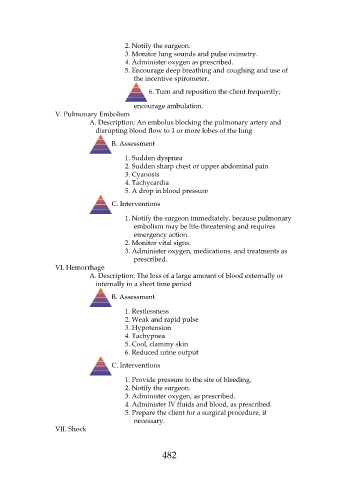Page 482 - Saunders Comprehensive Review For NCLEX-RN
P. 482
2. Notify the surgeon.
3. Monitor lung sounds and pulse oximetry.
4. Administer oxygen as prescribed.
5. Encourage deep breathing and coughing and use of
the incentive spirometer.
6. Turn and reposition the client frequently;
encourage ambulation.
V. Pulmonary Embolism
A. Description: An embolus blocking the pulmonary artery and
disrupting blood flow to 1 or more lobes of the lung
B. Assessment
1. Sudden dyspnea
2. Sudden sharp chest or upper abdominal pain
3. Cyanosis
4. Tachycardia
5. A drop in blood pressure
C. Interventions
1. Notify the surgeon immediately, because pulmonary
embolism may be life-threatening and requires
emergency action.
2. Monitor vital signs.
3. Administer oxygen, medications, and treatments as
prescribed.
VI. Hemorrhage
A. Description: The loss of a large amount of blood externally or
internally in a short time period
B. Assessment
1. Restlessness
2. Weak and rapid pulse
3. Hypotension
4. Tachypnea
5. Cool, clammy skin
6. Reduced urine output
C. Interventions
1. Provide pressure to the site of bleeding.
2. Notify the surgeon.
3. Administer oxygen, as prescribed.
4. Administer IV fluids and blood, as prescribed.
5. Prepare the client for a surgical procedure, if
necessary.
VII. Shock
482

